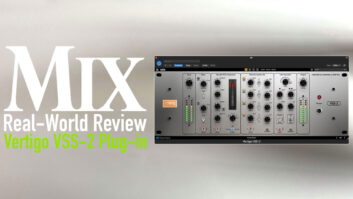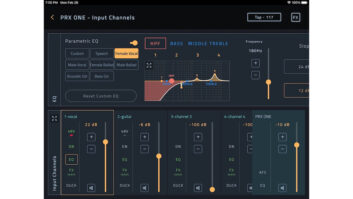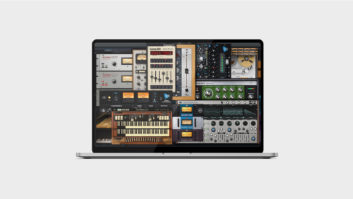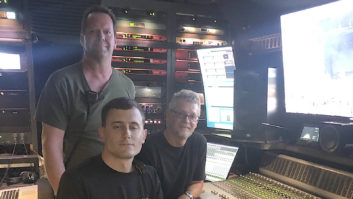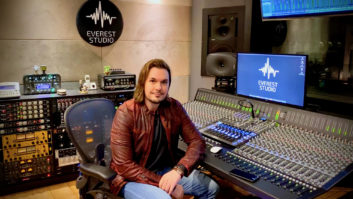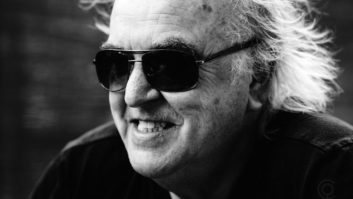Music mixes have always been defined by the release format. Back in the days of vinyl, physical limitations forced artists and engineers to weigh issues such as volume and EQ against track length. Later, cassette brought along its own advantages (and limitations), but digital really rocked the production world. When CD came along, engineers rejoiced in its increased dynamic range and reduced noise floor; it seemed the sky was the limit…
Stephen Marcussen
Actually, 0 dBfs was the limit. And unlike forgiving analog, there was no wiggle room. Yet over time, musical peaks, and then average volume, crept closer and closer to that limit, in time exhibiting squashed dynamics, increased clipping and flat-topped waveforms — a new “wall of sound,” so to speak.
There’s no denying that music is louder today than ever before. And the people closest to this issue, those in the trenches, are mastering engineers. It would be easy for them to throw up their hands in frustration, chalking up their woes to radio-obsessed record labels, a new production aesthetic or even a larger movement catering to an iPod-centric population with no concept of dynamic range or even active listening. But the truth is, if you ask 10 mastering engineers about the state of affairs, you would get 10 different answers. Not all music is loud. Not everyone equates loudness with dynamic range, and certainly not everyone thinks louder is bad. The one common denominator is most feel that the loudness argument is played out and it’s time to move on, to get beyond the “death of dynamics” rant and create the best mixes they can within a new sonic framework.
THE HISTORY OF HOT
“I’ve been at this a long time and this loudness war is nothing new. It’s been going on probably since dirt, and it’s not going to change,” says MasterMix’s Hank Williams, who — in three decades of mastering projects from Platinum artists Tim McGraw, Reba McEntire and Toby Keith to indie projects — certainly sees the big picture when it comes to the Nashville country scene and mastering in general.
Hank Williams
The long-standing loudness issue is a given, but the problem has grown out of control in recent years, say many engineers. Bob Katz, who’s been recording since the early ’70s and mastering out of his own facility, Digital Domain (Altamonte Springs, Fla.) since 1990, quantifies what he sees as a crisis: “There’s a 12 to 14dB apparent loudness difference between Black Sabbath, produced in 1977 or so and transferred to compact disc in the early ’80s, and the Black Eyed Peas’ ‘Let’s Get It Started,’” he says. “The difference between the loudest records and even the reasonably well-mastered records became so great that I can’t even make a reasonably loud ‘normal’ record without people complaining that it’s too low.”
Katz, who has worked with a full range of rock, pop, classical and jazz artists — including 150 records for the audiophile Chesky label, where he once served as technical director — paints a grim picture. “About three weeks ago, a very well-known jazz pianist, with a trio of some of the finest jazz musicians on the planet, said that he loved his master, but, ‘It’s not as loud as some of the more recent things, so I’m willing to sacrifice its sound to make it a little more competitive, loudness-wise.’ I’m thinking, ‘It has come to this? Why would you have to be the least bit concerned about a jazz recording being “competitively loud”?’ I’ve heard that even some classical musicians are beginning ‘loudness envy.’”
Though most engineers acknowledge that today’s music is louder, they don’t live in constant fear of squeezing the mix. “That’s the gig, you gotta rise to the occasion,” says Stephen Marcussen, head of Marcussen Mastering in Hollywood. “If it’s difficult, it’s difficult. It’s part of what we do. I have no problem if somebody comes in and makes an aggressive record; I quite enjoy it. But you’re talking to a guy who’s been accused of making records too loud.” Marcussen — whose resume spans Stevie Wonder’s 1980 Platinum album Hotter Than July to recent work with the Rolling Stones, Wolfmother, Audioslave, Gillian Welch and Jaguares — says some artists are even asking for lower volume. “Artists have come in and said, ‘Okay, make my record as loud as you can; now, turn it down 3 dB,’ which I thought was a nice, refreshing change in my world.”
Nashville mastering engineer Bob Olhsson, who’s been around since the Motown days, agrees that most would like to see average levels go down. “There are brave souls,” he says. “There’s an Alan Jackson record out right now [What I Do] that’s about 8 dB below average, and I think it sounds way better, especially streamed or as an MP3 file or something.”
Williams, who mastered that Jackson release, says he’s fortunate to work with established, involved artists. “Alan [Jackson] has some very specific things that he does and does not want done to his records, and I can tell you from my standpoint, those records do not suffer on the radio from being lower in level. It doesn’t happen. So the answer to the question is, what’s the point of this dynamic range war?”
Marcussen admits that engineers who voice frustration about the lack of dynamics make a valid point, but stresses that, ultimately, the client drives the master. “So it would be great for me to take a hard-line approach, but that’s not the reality,” he says. “The reality is that the guy I’m working with wants to be competitive in today’s world, so I think you have to respect the fact that there is good in having loud CDs. I didn’t say it was all good, but there is good.”
HOW DID WE GET HERE?
Various factors have contributed to music’s increasing loudness, but many point to our arguably most popular listening environment as the biggest culprit. Recently, noted mastering engineer Doug Sax — in an AES talk entitled “Whatever Happened to Dynamic Range and Why?” — put the problem succinctly: “The biggest virtue of the LP record — and why dynamic range is gone — is that it could not be played in the car.”
Bob Katz
With our cars (and increasingly our iPods) serving as our main listening environment, nobody will deny that music is suffering in its surroundings. But how much blame is legitimate here? “You couldn’t play LPs in the car; you listened at home and you had a pretty good stereo system, and you could enjoy the dynamic range of the recording,” says Katz. “In the car, there’s too much noise. But the dynamic range of many musical recordings has been reduced far beyond what is necessary to make it work in the car, so that particular reason or excuse has long passed. The fact that people are listening less critically than they used to is definitely a contributing factor.”
The issue is sometimes compounded by lack of experience on the mixing side. Joe Lambert is a mastering engineer at Trutone in New York; he regularly masters all genres of music, from Kanye West to Ted Nugent to Stephen Sondheim. He collaborates with both seasoned and newer mixing engineers — and hears a difference. “Before, you had 10 guys mixing records and 10 guys mastering records, and they all worked for record labels; everything was very controlled, very well-organized,” he says. “And then all of a sudden, you could buy your own CD burner. People started recording at home and they just didn’t keep up with professionally mixed and mastered productions. But they can’t hear why. They don’t know that it’s not just levels; they don’t know that it’s the proper balance between the highs and lows, the dynamic range — a combination of all these things. That’s what makes the art of mastering what it is.”
Katz adds that up-and-coming engineers often emulate squashed masters, which perpetuates the issue. “The easiest thing for any mastering engineer to do is make the master just a little bit louder than the mix,” he says. “When you combine that with mixing engineers more frequently emulating finished masters, it becomes a vicious circle.”
TOO MANY COOKS
The pressure to “make it louder” comes from all sides. “Motown was notorious for cutting some of the hottest 45s in the industry,” says Olhsson, who cut his teeth mastering hits like “Signed, Sealed, Delivered.” “Why do that? It all comes down to a bunch of people listening to five records, and four of them are gonna go into the wastebasket. Well, an artist, a manager, an A&R person or anybody who happens to be hanging out in that circumstance is going to quickly notice that something that is at a lower level is at a pretty big disadvantage. So there’s great paranoia that drives the level thing.”
Placing all the blame entirely on the record labels, however, would be missing the big picture. “Here in Nashville, with my major-label clientele, the labels are not really driving loudness wars or dynamic range,” says Williams. “Now there are producers and engineers who might request that of me, but it doesn’t come from the label.”
And mastering engineers aren’t the only ones feeling the squeeze. “It’s a chain of events that happens,” says Lambert. “There’s pressure on the mix engineers now because when they mix the song, they give it to the client and the client doesn’t understand why it doesn’t sound as loud as Mariah Carey’s record or Aerosmith’s record or whatever band they listen to. And part of the reason is because it’s not mastered.”
Genre and production aesthetics also play a part in shaping — but don’t categorically define — dynamics. Marcussen approaches each project on a case-by-case basis, but says that different genres can sometimes call for a particular approach to dynamics. “With dance music, for example, when you are in a club, it’s beneficial to have a louder CD. It’s more exciting, you’re not sitting there scrutinizing the sound; it’s more of a gut feeling rather than an intellectual comprehension of somebody’s work. So I think there are genres of music where it’s appropriate to make screamingly loud records.”
Joe Lambert
Olhsson stresses that, to a certain degree, the nature of the source materials dictates how loud the music can get. “That’s how we got into all this digital stuff — with the introduction of samplers and electronic music that didn’t have the kind of peak values that acoustically sourced music has.”
Katz agrees. “A sampled drum set just doesn’t have the transient response of a real drum set, nor does it have the impact that a real drummer has when he hits something loudly to his own musical feel. That also contributes to the highly compressed feel of the recording.”
Lambert, who’s mastered punk rock and musicals in the same week, says that overall, he applies the same philosophical approach regardless of style. “The goal is to make it easy for the average person to enjoy, to make it magical-sounding. It really doesn’t matter to me if it’s a metal song or an opera. It’s about listening to the elements and saying, ‘What’s going to make this track come alive?’”
Ultimately, mastering is a service industry, which requires balancing sonic ideas with artist needs. “My vision is my client’s vision,” says Williams. “I’m not here to put every record into the same bucket. That would be Dante’s 12th Circle of Hell if I were here to make every record sound exactly the same and have the same dynamic footprint or EQ footprint or whatever. Fortunately, I’ve got clients that all have different takes on how things should be done.”
“At Motown, we took getting songs on the air very, very seriously,” says Olhsson. “On one level, we wanted them to be good; on another level, we wanted them to be listenable, and we definitely did not want somebody else’s record to leap out of the speakers as compared to ours. So it’s compromising: You have to take all the factors, including experience, and put it in the context of the current market for that specific genre of music.”
Olhsson learned early on to benchmark himself against the competition. “I make sure that I’m familiar with what my recordings are going to be compared to, and I try and put myself on a conservative but still effective side of that,” he says. “I don’t want to just knee-jerk and turn stuff way up when there’s no reason on earth for it to be that way.”
EVOLVING WITH THE TIMES
When asked if they’re mastering differently in the context of smaller dynamic range, engineers are philosophical. “I think it’s an evolution of where I started, going back to 7-inch 45s, when it was significant that they were louder,” says Marcussen. “I think when you’re raised in that environment, you keep your competitive edge and take it to the next level, whether it’s CDs or MP3.”
Lambert says that in addition to setting his console VU meters at -6 instead of 0, he hasn’t made a lot of permanent concessions. “There’s nothing that I do just to make a record louder,” he says. “Everything I do is to make the record sound as good as I can — giving the client what they want while letting them know if I think we are going too far in volume and actually damaging the song.” Having a beautifully equipped mastering room doesn’t hurt, either, he admits, but he’s never bought any specific tools to make a record louder. “I’m sure that there are people out there who find [those tools] useful, but anytime I see the word ‘Max,’ I know it’s not for me,” he says with a laugh.
That said, engineers can still employ a few tricks to boost the mix. “Downward compressors can take the snap out of the transients, but upward compressors, or parallel compressors, can retain the transients more,” says Katz. “Another technique is to use several processors in a row and not push any one of them. If you start with a tube compressor or an optical compressor, or a combination of the two that has a very slow, gradual average response, you can raise the average level without losing too much of the snap.” Katz also advocates the judicious use of more intelligent peak limiters. He describes these maneuvers, however, as reluctant damage control. “None of this would be necessary if this were 1992. In other words, we’re pissing in the water to make it better.”
OPTIMIZING SOURCE MIXES
There are a few ways mixing engineers can help preserve dynamic range at the mix stage. “Some people think it’s a great idea to mix and get it all the way to what I’d call a ‘mastered level’ in their mix, and if that works for them and they can present the mastering facility with a good-sounding tape or file, I have no problem with that,” says Marcussen. “People seem to find their own level of comfort in working; maybe it’s a little dark, maybe it’s a little bright — those types of things can be compensated for at the mastering level.” That said, it’s sometimes helpful to get a glimpse of what the client sees as the “faux final product.” “Do I end up using their hyped one? Usually not,” Marcussen says. “But it’s helpful to use it as a guideline to see what the clients are looking for and how they want to take their product into the real world.”
Olhsson adds that the louder the lead vocal could be, the louder the record would seem, effectively. “Some prefer to send over alternate mixes with a lead vocal up or down a little; I’d prefer to have them do it maybe no more than a half dB up or a half dB down,” he explains. “When you put the peak limiting on, sometimes that will change the vocal’s position a little bit and you can nudge it up.”
Lambert asks the mixing engineers he works with to not use any limiting, but suggests an alternative. “Don’t do anything just to make the record louder,” he offers. “But once you’re done with the mixes, if you want, run them through an L2 or some other type of limiter and just make them a little louder and give that master to the client.”
Katz prefers that mixing engineers pass on mastering processing — especially peak limiting — and avoid clipping. “The rest is up to you aesthetically, but remember that dynamics are what make a recording lively, and if you’re not sweating bullets when you’re mixing, you’re probably over-compressing. What that means, of course, is you should have to ride faders.”
Williams advises mix engineers to keep perspective. “Here’s a great example of what I don’t want: When a mix comes in and never falls below -4 dBfs, and you call the mixer and say, ‘Man, the client is asking me to do some things in mastering and my hands are tied because of the dynamic range situation. Could you ease up on that and give me some more versions?’ And he says, ‘Then my mix will fall apart.’ Well, if your mix is going to fall apart, did you really even have one to begin with?” Williams stresses that this type of situation is generally the exception, “because the guys here in town are still mixing great records. And they allow the mastering houses the real estate to work with.”
THE MUSIC STILL RULES
Ultimately, the quality of the music defines success, and the mix is a big part of that. “There are some people in the industry who know how to structure a mix with smaller dynamic range and still come out with a great-sounding record,” says Williams. “My philosophy has always been the better it sounds, the better it sounds,” adds Marcussen. “So if somebody comes in with a beautiful-sounding tape, whether it goes through the Internet or not, the better it sounds to begin with, the better it sounds in the end.”
“The latest Tool record, Lateralus [2001], is not that loud,” says Lambert. “But you know what? Nobody cares. It didn’t affect sales of the record, it sounds awesome and, as a fan, you’re going to listen to it for years. Some records will work really loud; others wear on you: They sound great the first two times, but then you just stop listening because they fatigue your ear. I know that and the engineers know that, but the consumer doesn’t know why they’re not listening to those records anymore.”
Marcussen counters, “I don’t want to be averse or buck my peers, but I don’t see it as a problem. I see abuses of loudness as a problem, when the artifacts of loudness are unpleasant distortions that take away from the listening experience. But a really rocking, loud, well-mastered CD is great. It’s fun, it’s competitive, the music translates, the band gets its point across, the people involved with making the record are happy. What’s bad about that?”
Sax summed up the mastering engineer’s perspective in his AES speech: “If you process the music to win a shoot-out, the question I want you to think about is, would you like to listen to this yourself, for your own pleasure, in five years? And you’ll find a lot of times that you won’t, and that’s a very sad state because maybe the music that’s brought to you before you stood on it, before you competed with it, you liked and you could listen to it. And it was your hands that made it maybe not so listenable. Nobody else is going to hear that artist, ever, except for your signature that’s on that.”
Sarah Jones is Mix’s features editor.
SIDEBAR
The New Wall of Sound?
A VERY UNSCIENTIFIC LOOK AT THE EVOLUTION OF DYNAMICS
We compared waveform views of random
Billboard
hits from 1985 and 2005 for a representative glance at how dynamic range has evolved during the past 20 years. Top: from 1985, Whitney Houston’s “How Will I Know?” Bottom, one of this year’s biggest chart-toppers.
Bob Katz speaks on “decompressing his listening psychology,” names a few “dynamic discs,” and much more. Click here for the excerpts.
Click here to learn how to preserve dynamic range in the signal processing chain
Bob Olhsson on the lowest common denominator:
Going back to the 60s, a record was a luxury; the idea of it being a commodity was absurd to me. You didn’t buy a lot of recordings, you bought recordings that were special to you, and you listened to them over and over. And certainly you are less inclined to listen to a distorted record over and over and over then you are one that just sounds amazing. And I don’t think that’s a matter of being an audiophile, or a specialist, or anything else. I really believe the average person can tell the difference. They’re not going to identify what technically they’re hearing, but I definitely think that people are affected by sound and sound quality. I don’t buy the idea that it doesn’t matter and you should work to the lowest common denominator.
Mastering as a Service Provider?
More and more, mastering engineers find themselves in the role of educator when it comes to dynamics. “It’s a very hard thing to learn, when the dynamic range is right,” says Joe Lambert. “Unless you really take it so far that it’s squashed. But the subtlety is really hard to hear. What clients do notice is, why is my image starting to cave in? How come it doesn’t sound good?
It’s especially challenging to fight comparisons to other albums, and the “myth of radio,” the misguided notion that a louder mix will translate better through broadcast limiters. “There are times where I will point to some other single or record that’s current on the radio, and say ‘next time you hear this, listen to how great the intro and the first verse sound, and listen to the radio station totally crush it, mangle the high end, and the first chorus from there on out is softer than the first verse and the intro,’” says Hank Williams. “And you can go on and talk about why radio does that, but why create that kind of scenario when you know that’s what’s going to happen?”
“Over 90 percent of my clients fall into positions of trying to compare their CD against another CD, and I have to educate them very hard that they have their own volume control, and why the more dynamic lower average level CD sounds much better, and performs better on the radio as well,” says Bob Katz. “It’s a very long, hard educational process. It shouldn’t have been if there had been a standard level for compact disc when it was invented in 1980. So we got ourselves into this trouble way, way back. It took 25 years to reach a point where almost all mastering engineers admit that they’re making worse products on the average now than we did ten years ago.”
Useful Web Links:
· Stephen Marcussen talks to Electronic Musician
· Mastering for 5.1
· Bob Katz on Mastering Outside the Major Markets
· Here’s a link to Bob Katz’s various articles on digital
and analog audio
· “Dealing with the Peaks,” by Bob Katz
· “Compression In Mastering,” by Bob Katz
Dynamic Range: Then and Now (Click on image to enlarge)
Notice a pattern here?
